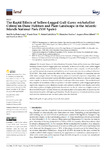The Rapid Effects of Yellow-Legged Gull (Larus michahellis) Colony on Dune Habitats and Plant Landscape in the Atlantic Islands National Park (NW Spain)

Use este enlace para citar
http://hdl.handle.net/2183/30737Colecciones
- Investigación (FCIE) [1227]
Metadatos
Mostrar el registro completo del ítemTítulo
The Rapid Effects of Yellow-Legged Gull (Larus michahellis) Colony on Dune Habitats and Plant Landscape in the Atlantic Islands National Park (NW Spain)Autor(es)
Fecha
2022-02-09Cita bibliográfica
Peña-Lastra, S.D.L.; Torre, F.; Carballeira, R.; Santiso, M.J.; Pérez-Alberti, A.; Otero, X.L. The Rapid Effects of Yellow-Legged Gull (Larus michahellis) Colony on Dune Habitats and Plant Landscape in the Atlantic Islands National Park (NW Spain). Land 2022, 11, 258. https://doi.org/10.3390/land11020258
Resumen
[Abstract] The Atlantic Islands of Galicia Maritime/Terrestrial National Park hosts one of the largest breeding colonies of yellow-legged gull (Larus michahellis) in the world. In 2002, a new yellow-legged gull breeding colony was established on the Punta Muxieiro dune complex, which also harbors rare and threatened plant species and habitat types of community interest according to Directive 92/43/EEC. This study assesses the effect of this colony on two habitats of community interest: white dunes and grey dunes. For this purpose, plant cover and soil properties, composition, and nutrient content were monitored in plots with different gull densities. Moreover, historic aerial images were compiled to observe changes in the plant landscape of the dune system. The results showed that, despite the recentness of the occupation of the dune system by yellow-legged gull species, significant changes in acidic–alkaline processes and nutrient availability were already observed in soils. Soils in plots with higher gull density showed more acidic pH values and a higher content of the most labile N and P fractions. Moreover, a decrease in plant cover and number of species was also demonstrated in plots with higher gull densities. Finally, the presence of ruderal and alien species such as Urtica membranacea and Parietaria judaica was also observed.
Palabras clave
Gull
Nitrogen
Phosphorus
Soil
Dune plants
Nitrogen
Phosphorus
Soil
Dune plants
Versión del editor
Derechos
Atribución 3.0 España
ISSN
2073-445X






